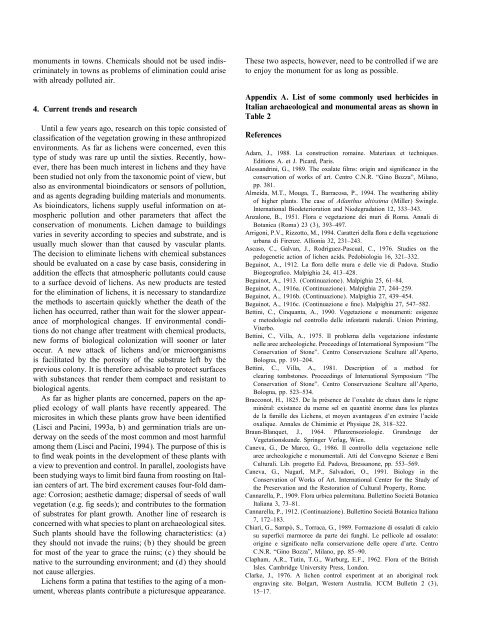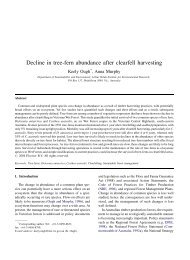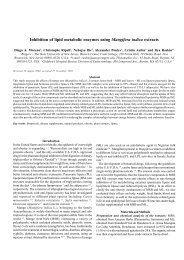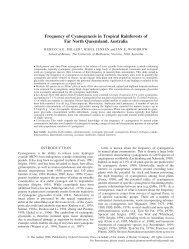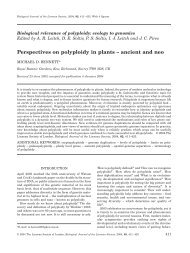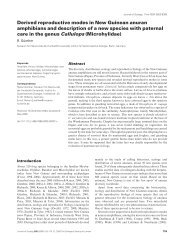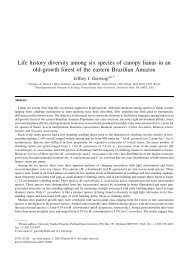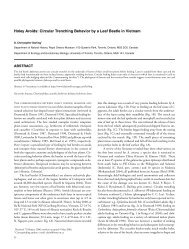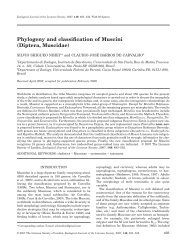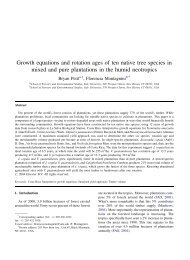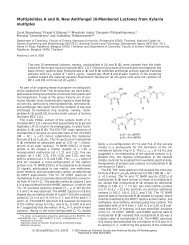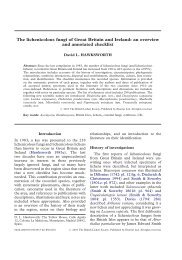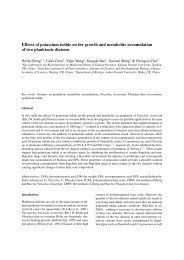Lichens and higher plants on stone: a review - AseanBiodiversity.info
Lichens and higher plants on stone: a review - AseanBiodiversity.info
Lichens and higher plants on stone: a review - AseanBiodiversity.info
Create successful ePaper yourself
Turn your PDF publications into a flip-book with our unique Google optimized e-Paper software.
m<strong>on</strong>uments in towns. Chemicals should not be used indiscriminately<br />
in towns as problems of eliminati<strong>on</strong> could arise<br />
withalready polluted air.<br />
4. Current trends <str<strong>on</strong>g>and</str<strong>on</strong>g> research<br />
Until a few years ago, research<strong>on</strong> this topic c<strong>on</strong>sisted of<br />
classi cati<strong>on</strong> of the vegetati<strong>on</strong> growing in these anthropized<br />
envir<strong>on</strong>ments. As far as lichens were c<strong>on</strong>cerned, even this<br />
type of study was rare up until the sixties. Recently, however,<br />
there has been much interest in lichens <str<strong>on</strong>g>and</str<strong>on</strong>g> they have<br />
been studied not <strong>on</strong>ly from the tax<strong>on</strong>omic point of view, but<br />
also as envir<strong>on</strong>mental bioindicators or sensors of polluti<strong>on</strong>,<br />
<str<strong>on</strong>g>and</str<strong>on</strong>g> as agents degrading building materials <str<strong>on</strong>g>and</str<strong>on</strong>g> m<strong>on</strong>uments.<br />
As bioindicators, lichens supply useful <strong>info</strong>rmati<strong>on</strong> <strong>on</strong> atmospheric<br />
polluti<strong>on</strong> <str<strong>on</strong>g>and</str<strong>on</strong>g> other parameters that a ect the<br />
c<strong>on</strong>servati<strong>on</strong> of m<strong>on</strong>uments. Lichen damage to buildings<br />
varies in severity according to species <str<strong>on</strong>g>and</str<strong>on</strong>g> substrate, <str<strong>on</strong>g>and</str<strong>on</strong>g> is<br />
usually much slower than that caused by vascular <str<strong>on</strong>g>plants</str<strong>on</strong>g>.<br />
The decisi<strong>on</strong> to eliminate lichens with chemical substances<br />
should be evaluated <strong>on</strong> a case by case basis, c<strong>on</strong>sidering in<br />
additi<strong>on</strong> the e ects that atmospheric pollutants could cause<br />
to a surface devoid of lichens. As new products are tested<br />
for the eliminati<strong>on</strong> of lichens, it is necessary to st<str<strong>on</strong>g>and</str<strong>on</strong>g>ardize<br />
the methods to ascertain quickly whether the death of the<br />
lichen has occurred, rather than wait for the slower appearance<br />
of morphological changes. If envir<strong>on</strong>mental c<strong>on</strong>diti<strong>on</strong>s<br />
do not change after treatment with chemical products,<br />
new forms of biological col<strong>on</strong>izati<strong>on</strong> will so<strong>on</strong>er or later<br />
occur. A new attack of lichens <str<strong>on</strong>g>and</str<strong>on</strong>g>=or microorganisms<br />
is facilitated by the porosity of the substrate left by the<br />
previous col<strong>on</strong>y. It is therefore advisable to protect surfaces<br />
with substances that render them compact <str<strong>on</strong>g>and</str<strong>on</strong>g> resistant to<br />
biological agents.<br />
As far as <str<strong>on</strong>g>higher</str<strong>on</strong>g> <str<strong>on</strong>g>plants</str<strong>on</strong>g> are c<strong>on</strong>cerned, papers <strong>on</strong> the applied<br />
ecology of wall <str<strong>on</strong>g>plants</str<strong>on</strong>g> have recently appeared. The<br />
microsites in which these <str<strong>on</strong>g>plants</str<strong>on</strong>g> grow have been identi ed<br />
(Lisci <str<strong>on</strong>g>and</str<strong>on</strong>g> Pacini, 1993a, b) <str<strong>on</strong>g>and</str<strong>on</strong>g> germinati<strong>on</strong> trials are underway<br />
<strong>on</strong> the seeds of the most comm<strong>on</strong> <str<strong>on</strong>g>and</str<strong>on</strong>g> most harmful<br />
am<strong>on</strong>g them (Lisci <str<strong>on</strong>g>and</str<strong>on</strong>g> Pacini, 1994). The purpose of this is<br />
to nd weak points in the development of these <str<strong>on</strong>g>plants</str<strong>on</strong>g> with<br />
a view to preventi<strong>on</strong> <str<strong>on</strong>g>and</str<strong>on</strong>g> c<strong>on</strong>trol. In parallel, zoologists have<br />
been studying ways to limit bird fauna from roosting <strong>on</strong> Italian<br />
centers of art. The bird excrement causes four-fold damage:<br />
Corrosi<strong>on</strong>; aesthetic damage; dispersal of seeds of wall<br />
vegetati<strong>on</strong> (e.g. g seeds); <str<strong>on</strong>g>and</str<strong>on</strong>g> c<strong>on</strong>tributes to the formati<strong>on</strong><br />
of substrates for plant growth. Another line of research is<br />
c<strong>on</strong>cerned with what species to plant <strong>on</strong> archaeological sites.<br />
Such <str<strong>on</strong>g>plants</str<strong>on</strong>g> should have the following characteristics: (a)<br />
they should not invade the ruins; (b) they should be green<br />
for most of the year to grace the ruins; (c) they should be<br />
native to the surrounding envir<strong>on</strong>ment; <str<strong>on</strong>g>and</str<strong>on</strong>g> (d) they should<br />
not cause allergies.<br />
<str<strong>on</strong>g>Lichens</str<strong>on</strong>g> form a patina that testi es to the aging of a m<strong>on</strong>ument,<br />
whereas <str<strong>on</strong>g>plants</str<strong>on</strong>g> c<strong>on</strong>tribute a picturesque appearance.<br />
These two aspects, however, need to be c<strong>on</strong>trolled if we are<br />
to enjoy the m<strong>on</strong>ument for as l<strong>on</strong>g as possible.<br />
Appendix A. List of some comm<strong>on</strong>ly used herbicides in<br />
Italian archaeological <str<strong>on</strong>g>and</str<strong>on</strong>g> m<strong>on</strong>umental areas as shown in<br />
Table 2<br />
References<br />
Adam, J., 1988. La c<strong>on</strong>structi<strong>on</strong> romaine. Materiaux et techniques.<br />
Editi<strong>on</strong>s A. et J. Picard, Paris.<br />
Aless<str<strong>on</strong>g>and</str<strong>on</strong>g>rini, G., 1989. The oxalate lms: origin <str<strong>on</strong>g>and</str<strong>on</strong>g> signi cance in the<br />
c<strong>on</strong>servati<strong>on</strong> of works of art. Centro C.N.R. “Gino Bozza”, Milano,<br />
pp. 381.<br />
Almeida, M.T., Mouga, T., Barracosa, P., 1994. The weathering ability<br />
of <str<strong>on</strong>g>higher</str<strong>on</strong>g> <str<strong>on</strong>g>plants</str<strong>on</strong>g>. The case of Ailanthus altissima (Miller) Swingle.<br />
Internati<strong>on</strong>al Biodeteriorati<strong>on</strong> <str<strong>on</strong>g>and</str<strong>on</strong>g> Niodegradati<strong>on</strong> 12, 333–343.<br />
Anzal<strong>on</strong>e, B., 1951. Flora e vegetazi<strong>on</strong>e dei muri di Roma. Annali di<br />
Botanica (Roma) 23 (3), 393–497.<br />
Arrig<strong>on</strong>i, P.V., Rizzotto, M., 1994. Caratteri della ora e della vegetazi<strong>on</strong>e<br />
urbana di Firenze. Alli<strong>on</strong>ia 32, 231–243.<br />
Ascaso, C., Galvan, J., Rodriguez-Pascual, C., 1976. Studies <strong>on</strong> the<br />
pedogenetic acti<strong>on</strong> of lichen acids. Pedobiologia 16, 321–332.<br />
Beguinot, A., 1912. La ora delle mura e delle vie di Padova. Studio<br />
Biogeogra co. Malpighia 24, 413–428.<br />
Beguinot, A., 1913. (C<strong>on</strong>tinuazi<strong>on</strong>e). Malpighia 25, 61–84.<br />
Beguinot, A., 1916a. (C<strong>on</strong>tinuazi<strong>on</strong>e). Malpighia 27, 244–259.<br />
Beguinot, A., 1916b. (C<strong>on</strong>tinuazi<strong>on</strong>e). Malpighia 27, 439–454.<br />
Beguinot, A., 1916c. (C<strong>on</strong>tinuazi<strong>on</strong>e e ne). Malpighia 27, 547–582.<br />
Bettini, C., Cinquanta, A., 1990. Vegetazi<strong>on</strong>e e m<strong>on</strong>umenti: esigenze<br />
e metodologie nel c<strong>on</strong>trollo delle infestanti ruderali. Uni<strong>on</strong> Printing,<br />
Viterbo.<br />
Bettini, C., Villa, A., 1975. Il problema della vegetazi<strong>on</strong>e infestante<br />
nelle aree archeologiche. Proceedings of Internati<strong>on</strong>al Symposium “The<br />
C<strong>on</strong>servati<strong>on</strong> of St<strong>on</strong>e”. Centro C<strong>on</strong>servazi<strong>on</strong>e Sculture all’Aperto,<br />
Bologna, pp. 191–204.<br />
Bettini, C., Villa, A., 1981. Descripti<strong>on</strong> of a method for<br />
clearing tombst<strong>on</strong>es. Proceedings of Internati<strong>on</strong>al Symposium “The<br />
C<strong>on</strong>servati<strong>on</strong> of St<strong>on</strong>e”. Centro C<strong>on</strong>servazi<strong>on</strong>e Sculture all’Aperto,<br />
Bologna, pp. 523–534.<br />
Bracc<strong>on</strong>ot, H., 1825. De la presence de l’oxalate de chaux dans le regne<br />
mineral: existance du meme sel en quantite enorme dans les plantes<br />
de la famille des <str<strong>on</strong>g>Lichens</str<strong>on</strong>g>, et moyen avantageux d’en extraire l’acide<br />
oxalique. Annales de Chimimie et Physique 28, 318–322.<br />
Braun-Blanquet, J., 1964. P anzensoziologie. Grundzuge der<br />
Vegetati<strong>on</strong>skunde. Springer Verlag, Wien.<br />
Caneva, G., De Marco, G., 1986. Il c<strong>on</strong>trollo della vegetazi<strong>on</strong>e nelle<br />
aree archeologiche e m<strong>on</strong>umentali. Atti del C<strong>on</strong>vegno Scienze e Beni<br />
Culturali. Lib. progetto Ed. Padova, Bressan<strong>on</strong>e, pp. 553–569.<br />
Caneva, G., NugarI, M.P., Salvadori, O., 1991. Biology in the<br />
C<strong>on</strong>servati<strong>on</strong> of Works of Art. Internati<strong>on</strong>al Center for the Study of<br />
the Preservati<strong>on</strong> <str<strong>on</strong>g>and</str<strong>on</strong>g> the Restorati<strong>on</strong> of Cultural Property, Rome.<br />
Cannarella, P., 1909. Flora urbica palermitana. Bullettino Societa Botanica<br />
Italiana 3, 73–81.<br />
Cannarella, P., 1912. (C<strong>on</strong>tinuazi<strong>on</strong>e). Bullettino Societa Botanica Italiana<br />
7, 172–183.<br />
Chiari, G., Sampo, S., Torraca, G., 1989. Formazi<strong>on</strong>e di ossalati di calcio<br />
su super ci marmoree da parte dei funghi. Le pellicole ad ossalato:<br />
origine e signi cato nella c<strong>on</strong>servazi<strong>on</strong>e delle opere d’arte. Centro<br />
C.N.R. “Gino Bozza”, Milano, pp. 85–90.<br />
Clapham, A.R., Tutin, T.G., Warburg, E.F., 1962. Flora of the British<br />
Isles. Cambridge University Press, L<strong>on</strong>d<strong>on</strong>.<br />
Clarke, J., 1976. A lichen c<strong>on</strong>trol experiment at an aboriginal rock<br />
engraving site. Bolgart, Western Australia. ICCM Bulletin 2 (3),<br />
15–17.


